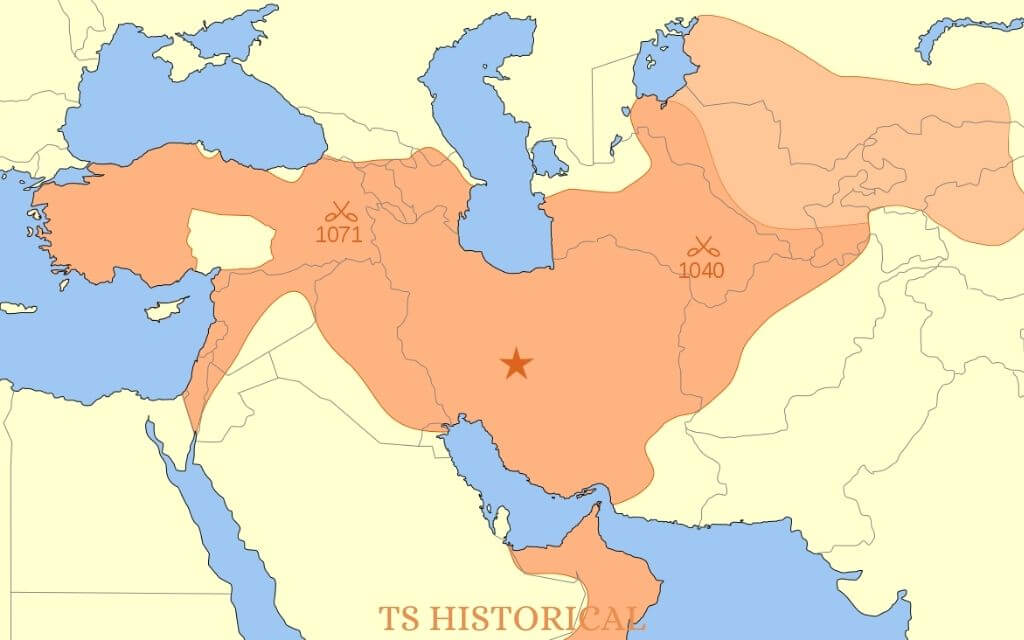Table of Content
Rise and Fall of the Seljuk Empire
Rise and Fall of the Seljuk Empire

The Seljuk Empire or Seljuq Empire (Turkish: Büyük Selçuklu Devleti; Persian: دولت سلجوقیان, Daulat-i-Saljuqian; English: Seljuq Empire) was a medieval Turkish empire that lasted from 1037 to 1194 AD. It was spread over a very large area that extended from the Hindu Kush mountains in the east to Anatolia in the west and from Central Asia in the north to the Persian Gulf in the south. The Seljuq people originated from the Qinik sub-branch of the Oghuz branch of the Turkic-speaking peoples of the steppe region of Central Asia. Their original homeland was near the Aral Sea, from where they first captured Khorasan, then Iran, and then Anatolia. The Seljuq Empire led to the influence of Turkish culture in Iran, northern Afghanistan, the Caucasus, and other areas, and a mixed Iranian-Turkish cultural tradition.
Name and Origin
Seljuq Begh was a high official in the Oghuz Yabgu kingdom, located in the region between the Aral Sea and the Caspian Sea, and the empire was named ‘Seljuq’ after him. He separated his tribe and first camped on the banks of Sir Darya, where this tribe also adopted Islam. After this, his grandsons Tughril Beg and Chaghri Beg started spreading in Khorasan where they used to loot. When the local Ghaznavi Empire tried to stop them, the Ghaznavids were defeated in the Battle of Dandanqan on 23 May 1040. The Seljuq people became the masters of Khorasan and then they also occupied the Amu-Par region and Iran. By 1055, Tughril Beg had extended his territory as far as Baghdad, where the Abbasi caliphate gave him the title of Sultan, which became the title of all subsequent Seljuq rulers. Although the Shia branch of Islam was flourishing in Iran at the time, the Seljuqs were Sunni and the policies of the Seljuqs were a major reason for the presence of more Sunnis than Shiites in the modern Middle East.
The history of the Seljuk Empire in Anatolia begins with the historic defeat of Byzantium by Sultan Alif Arsalan in Malazgar in 1071 AD. after the battle of Manzikert, the Seljuk commander Suleiman ibn Qutulmish, a distant cousin of Malik-Shah I and a former contender for the throne of the Seljuk Empire, came to power in western Anatolia. In 1075, he captured the Byzantine cities of Nicaea (İznik) and Nicomedia (İzmit). it was 1077 AD when the foundation of the Roman Empire was laid and almost for 150 years Seljuki ruled Anatolia during this they faced a lot of Crusaders who came to Qustantuniya after ruling 150 years in Anatolia their decline began the main reason for this is the attack of Mongols on Anatolia and start controlling them sultan Alauddin Kayqubad was the 12th sultan of this kingdom who controls the thorn in 1220 AD and stayed ruler until his death in 1237 AD
Mongol conquest of the Khwarazmian Empire

Mongol conquest of the Khwarazmian Empire
The reign of Kayqubad I is called the golden age in Roman history But the year of the accession of Kayqubad I is the same year that Genghis Khan defeated the Khwarizm Empire in 1220 and its borders extended to Asia Minor. After the defeat of the Khwarizmi Empire, the borders of the Seljuk Empire merged directly with the Mongol Empire. and in the reign of Kayqubad I, Mongols already starts attacking Anatolia but till the death of Kayqubad I, Mongols Avoid to attack directly Seljuk empire In the reign of Kayqubad I , we found the name of Ertugrul Ghazi first time who helped the army of Kayqubad I and Saved from defeat and that’s why the area of sight was given to them as a property the basic reason for this is to decrease the attack chance from byzantine empire In 1237AD, after the death of Kayqubad I his son Ghiyasuddin became the king But he could not come up with any special strategy against the Mongols
Mongol invasions of Anatolia
In 1243 AD, In the famous battle of Kose Dag, Seljuks room gets defeated badly by the Mongols and Ghiyasuddin escaped from battle The Mongols established their influence in most of Anatolia but were reluctant to seize the Seljuk capital, Konya. This was due to the strong support of the Seljuks among the spokesman tribes of Anatolia after three years of this war, Sultan Ghiyasuddin died because of a bite of wild animals. According to some, he was martyred by the Mongols through conspiracy after this the eleven-year-old son of Ghiyasuddin, Izuden kaka became the new king of the Seljuk empire Due to their young age and inexperience, the Mongol influence on Anatolia deepened over time. due to civil war and Palace conspiracies, izuden kaka was have to share his thorn with his two other brothers due to which the Seljuk empire divided and became weak on the other hand the interference of Mongols in Anatolia have reached the capital of the Seljuks Empire Konya in 1256 AD, Izuden kakabus gather the remaining Seljuk empire and Rebellion against Mongols to evict them from Anatolia.
Discover more from TS HISTORICAL
Subscribe to get the latest posts sent to your email.

